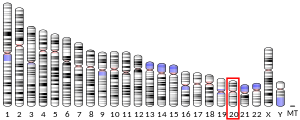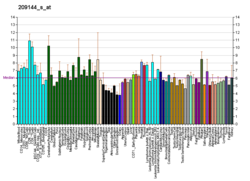Protein CBFA2T2 is a protein that in humans is encoded by the CBFA2T2 gene.[5][6]
Function
editIn acute myeloid leukemia, especially in the M2 subtype, the t(8;21)(q22;q22) translocation is one of the most frequent karyotypic abnormalities. The translocation produces a chimeric gene made up of the 5'-region of the RUNX1 (AML1) gene fused to the 3'-region of the CBFA2T1 (MTG8) gene. The chimeric protein is thought to associate with the nuclear corepressor/histone deacetylase complex to block hematopoietic differentiation. The protein encoded by this gene binds to the AML1-MTG8 complex and may be important in promoting leukemogenesis. Several transcript variants are thought to exist for this gene, but the full-length natures of only three have been described.[6]
Interactions
editReferences
edit- ^ a b c GRCh38: Ensembl release 89: ENSG00000078699 – Ensembl, May 2017
- ^ a b c GRCm38: Ensembl release 89: ENSMUSG00000038533 – Ensembl, May 2017
- ^ "Human PubMed Reference:". National Center for Biotechnology Information, U.S. National Library of Medicine.
- ^ "Mouse PubMed Reference:". National Center for Biotechnology Information, U.S. National Library of Medicine.
- ^ Calabi F, Cilli V (December 1998). "CBFA2T1, a gene rearranged in human leukemia, is a member of a multigene family". Genomics. 52 (3): 332–41. doi:10.1006/geno.1998.5429. PMID 9790752.
- ^ a b "Entrez Gene: CBFA2T2 core-binding factor, runt domain, alpha subunit 2; translocated to, 2".
- ^ Rual JF, Venkatesan K, Hao T, Hirozane-Kishikawa T, Dricot A, Li N, Berriz GF, Gibbons FD, Dreze M, Ayivi-Guedehoussou N, Klitgord N, Simon C, Boxem M, Milstein S, Rosenberg J, Goldberg DS, Zhang LV, Wong SL, Franklin G, Li S, Albala JS, Lim J, Fraughton C, Llamosas E, Cevik S, Bex C, Lamesch P, Sikorski RS, Vandenhaute J, Zoghbi HY, Smolyar A, Bosak S, Sequerra R, Doucette-Stamm L, Cusick ME, Hill DE, Roth FP, Vidal M (October 2005). "Towards a proteome-scale map of the human protein–protein interaction network". Nature. 437 (7062): 1173–8. Bibcode:2005Natur.437.1173R. doi:10.1038/nature04209. PMID 16189514. S2CID 4427026.
- ^ Lindberg SR, Olsson A, Persson AM, Olsson I (December 2003). "Interactions between the leukaemia-associated ETO homologues of nuclear repressor proteins". Eur. J. Haematol. 71 (6): 439–47. doi:10.1046/j.0902-4441.2003.00166.x. PMID 14703694. S2CID 23106882.
- ^ Hoogeveen AT, Rossetti S, Stoyanova V, Schonkeren J, Fenaroli A, Schiaffonati L, van Unen L, Sacchi N (September 2002). "The transcriptional corepressor MTG16a contains a novel nucleolar targeting sequence deranged in t (16; 21)-positive myeloid malignancies". Oncogene. 21 (43): 6703–12. doi:10.1038/sj.onc.1205882. PMID 12242670.
Further reading
edit- Kitabayashi I, Ida K, Morohoshi F, Yokoyama A, Mitsuhashi N, Shimizu K, Nomura N, Hayashi Y, Ohki M (1998). "The AML1-MTG8 leukemic fusion protein forms a complex with a novel member of the MTG8(ETO/CDR) family, MTGR1". Mol. Cell. Biol. 18 (2): 846–58. doi:10.1128/MCB.18.2.846. PMC 108796. PMID 9447981.
- Fracchiolla NS, Colombo G, Finelli P, Maiolo AT, Neri A (1998). "EHT, a new member of the MTG8/ETO gene family, maps on 20q11 region and is deleted in acute myeloid leukemias". Blood. 92 (9): 3481–4. doi:10.1182/blood.V92.9.3481. PMID 9787195.
- Morohoshi F, Mitani S, Mitsuhashi N, Kitabayashi I, Takahashi E, Suzuki M, Munakata N, Ohki M (2000). "Structure and expression pattern of a human MTG8/ETO family gene, MTGR1". Gene. 241 (2): 287–95. doi:10.1016/S0378-1119(99)00481-3. PMID 10675041.
- Hoogeveen AT, Rossetti S, Stoyanova V, Schonkeren J, Fenaroli A, Schiaffonati L, van Unen L, Sacchi N (2002). "The transcriptional corepressor MTG16a contains a novel nucleolar targeting sequence deranged in t (16; 21)-positive myeloid malignancies". Oncogene. 21 (43): 6703–12. doi:10.1038/sj.onc.1205882. PMID 12242670.
- Lindberg SR, Olsson A, Persson AM, Olsson I (2004). "Interactions between the leukaemia-associated ETO homologues of nuclear repressor proteins". Eur. J. Haematol. 71 (6): 439–47. doi:10.1046/j.0902-4441.2003.00166.x. PMID 14703694. S2CID 23106882.
- Brandenberger R, Wei H, Zhang S, Lei S, Murage J, Fisk GJ, Li Y, Xu C, Fang R, Guegler K, Rao MS, Mandalam R, Lebkowski J, Stanton LW (2005). "Transcriptome characterization elucidates signaling networks that control human ES cell growth and differentiation". Nat. Biotechnol. 22 (6): 707–16. doi:10.1038/nbt971. PMID 15146197. S2CID 27764390.
- Beausoleil SA, Jedrychowski M, Schwartz D, Elias JE, Villén J, Li J, Cohn MA, Cantley LC, Gygi SP (2004). "Large-scale characterization of HeLa cell nuclear phosphoproteins". Proc. Natl. Acad. Sci. U.S.A. 101 (33): 12130–5. Bibcode:2004PNAS..10112130B. doi:10.1073/pnas.0404720101. PMC 514446. PMID 15302935.
- Zhang J, Kalkum M, Yamamura S, Chait BT, Roeder RG (2004). "E protein silencing by the leukemogenic AML1-ETO fusion protein". Science. 305 (5688): 1286–9. Bibcode:2004Sci...305.1286Z. doi:10.1126/science.1097937. PMID 15333839. S2CID 850967.
- Rual JF, Venkatesan K, Hao T, Hirozane-Kishikawa T, Dricot A, Li N, Berriz GF, Gibbons FD, Dreze M, Ayivi-Guedehoussou N, Klitgord N, Simon C, Boxem M, Milstein S, Rosenberg J, Goldberg DS, Zhang LV, Wong SL, Franklin G, Li S, Albala JS, Lim J, Fraughton C, Llamosas E, Cevik S, Bex C, Lamesch P, Sikorski RS, Vandenhaute J, Zoghbi HY, Smolyar A, Bosak S, Sequerra R, Doucette-Stamm L, Cusick ME, Hill DE, Roth FP, Vidal M (2005). "Towards a proteome-scale map of the human protein–protein interaction network". Nature. 437 (7062): 1173–8. Bibcode:2005Natur.437.1173R. doi:10.1038/nature04209. PMID 16189514. S2CID 4427026.
- Lim J, Hao T, Shaw C, Patel AJ, Szabó G, Rual JF, Fisk CJ, Li N, Smolyar A, Hill DE, Barabási AL, Vidal M, Zoghbi HY (2006). "A protein–protein interaction network for human inherited ataxias and disorders of Purkinje cell degeneration". Cell. 125 (4): 801–14. doi:10.1016/j.cell.2006.03.032. PMID 16713569. S2CID 13709685.
- Kumar R, Manning J, Spendlove HE, Kremmidiotis G, McKirdy R, Lee J, Millband DN, Cheney KM, Stampfer MR, Dwivedi PP, Morris HA, Callen DF (2006). "ZNF652, a novel zinc finger protein, interacts with the putative breast tumor suppressor CBFA2T3 to repress transcription". Mol. Cancer Res. 4 (9): 655–65. doi:10.1158/1541-7786.MCR-05-0249. PMID 16966434.
External links
edit- CBFA2T2+protein,+human at the U.S. National Library of Medicine Medical Subject Headings (MeSH)
- Human CBFA2T2 genome location and CBFA2T2 gene details page in the UCSC Genome Browser.
This article incorporates text from the United States National Library of Medicine, which is in the public domain.






